
Manthey's Katmai Journal
This is an excerpt from my Katmai journal. I have already been at Katmai for four days looking at bears, and I am now hiking into the Valley of 10,000 Smokes. This text is Copyright 1996 by David Manthey. All rights reserved.
Wednesday dawns slightly chilly and very revolting. Not 15 yards from the campground water spigot is a dead bear cub, courtesy of a bear territorial dispute. Despite this, I pack up all my stuff and have a hasty
breakfast. I then get to trek through the woods (too many bears on the beach and campground trail) with all my stuff (my backpack and a duffel with the stuff I am leaving behind). Ugh.
I get to ride the bus with the tour going to see the Valley of 10,000 Smokes. This travels on THE road in the park, which stretches 23 miles from Brooks Camp (where I am staying) to the foot of the Valley. The bus ride out and back costs $60. Outrageous, but what else can I do but pay? This is led by a 'guide', Greg. He is fairly good at telling stories, though a bit mean in his jokes.
The bus stopped three times on the way out. The first time was to babble about bears. At this point I've seen and heard enough bears to be nearly sick of them. The second stop was a scenic overlook, looking down on Research Bay. This is part of Naknek Lake, where Griggs and company came into the area. The third stop was at restrooms.
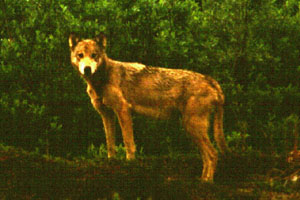 The bus then forded three shallow streams (one fairly wide). Sometime after this the German couple pointed out a wolf. Eventually we alarmed the bus driver enough to stop. I managed to get the correct lens on my camera and the window open in time to actually get a couple of photographs, which I hope came out well. After this we drove by a beaver pond with a huge lodge, then into an area with the first glimpse of the Valley. Here the guide said we could begin to see a brown area (I wasn't sure what area he was talking about).
The bus then forded three shallow streams (one fairly wide). Sometime after this the German couple pointed out a wolf. Eventually we alarmed the bus driver enough to stop. I managed to get the correct lens on my camera and the window open in time to actually get a couple of photographs, which I hope came out well. After this we drove by a beaver pond with a huge lodge, then into an area with the first glimpse of the Valley. Here the guide said we could begin to see a brown area (I wasn't sure what area he was talking about).
Eventually the bus will arrive at the Windy Creek Lookout, where there is a small cabin. This cabin is left open as a shelter and emergency supply for hikers. I am let off 2/3 mile before we reach the Lookout, and I am to be picked up at the Lookout on Friday.
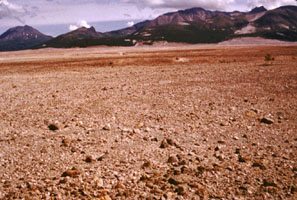 From my dropoff point you can look down on the Valley of 10,000 Smokes, which isn't all that impressive from there. The Valley is fifteen plus miles long and four miles wide. It looks to be a desert-like ash field with occasional blowing sand (ash, really). This is framed on one side by the Buttress Range, a series of low mountains as high as 3500 feet. The Valley floor is at 1100 feet at the base and 2000 feet at the top. On the other side of the Valley is Mount Griggs (7600+ feet), what is left of Mount Katmai (at one time a rival of Mount Griggs in height, now only 5000 feet at its highest), Baked and Broken Mountains (two scorched-earth hills of 3700 feet or so), and a few other mountains. At the far end of the Valley lie Mount Mageik (on the Buttress Range side) and Mount Trident, both active volcanoes which release steam at times. Novarupta, the source of the desolation, lies between Baked Mountain, Mount Katmai, and Trident Mountain.
From my dropoff point you can look down on the Valley of 10,000 Smokes, which isn't all that impressive from there. The Valley is fifteen plus miles long and four miles wide. It looks to be a desert-like ash field with occasional blowing sand (ash, really). This is framed on one side by the Buttress Range, a series of low mountains as high as 3500 feet. The Valley floor is at 1100 feet at the base and 2000 feet at the top. On the other side of the Valley is Mount Griggs (7600+ feet), what is left of Mount Katmai (at one time a rival of Mount Griggs in height, now only 5000 feet at its highest), Baked and Broken Mountains (two scorched-earth hills of 3700 feet or so), and a few other mountains. At the far end of the Valley lie Mount Mageik (on the Buttress Range side) and Mount Trident, both active volcanoes which release steam at times. Novarupta, the source of the desolation, lies between Baked Mountain, Mount Katmai, and Trident Mountain.
There is no official trail down to the Valley. So saying, the unofficial trail is fairly obvious for the first six miles, then vanishes entirely. A further note about the Valley layout. The Buttress Range runs almost due north-south (map, not compass). The Valley is to the east of this, and runs more northwest-southeast. To the west of the Buttress Range is Windy Creek. Within the Valley is the River Lethe (final e pronounced), plus Knife Creek (separating Baked Mountain and Mount Griggs), with the Ukak River below Mount Griggs (near the north end, near Windy Creek Lookout).
The trail starts to the west of the lookout, and for the first mile winds down through obnoxiously thick willow and cottonwood. I am wearing shorts and gaiters, and this hurts my knees some. After this, the trail emerges onto a desolate (or so I currently think) ash plain. Here the ground is soft enough that footsteps leave definite impressions (about 1/2 inch deep of so). The trail nears Windy Creek, and, almost immediately, side trails lead down to the water. No bridges here, one must wade across. I proceed upstream another mile or so, then wade across at a shallow section. The water comes up to a few inches below the top of my gaiters. The left boot-gaiter combo worked like a charm, but the right one floods and soaks my foot. This dries as I proceed.
On the opposite side of Windy Creek, the trail resumes. I emerge from a gully with a white chalk line. The trail winds through the ash field for several miles, passing occasional drainages with shrub willow growing along them. A few of these drainages even have surface water. Between drainages all is dead (though again, compared to what comes later, the few tufts of grass here make it bursting with life). About three miles out I pass a tent. This I assume to be three-mile camp (a designation arbitrarily given to a spot roughly three miles (beeline distance) from the Lookout). It is closer to four miles to this point.
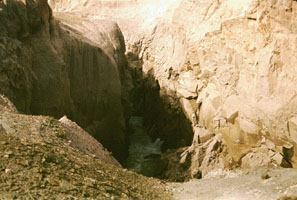 Shortly after passing this point, the trail is squeezed in between the sharp sides of the Buttress Range and the chasm which holds the River Lethe. The River Lethe is an awesome spectacle. Although no gullies channel water to it, it still receives a significant quantity of ash-silt laden water. These pour from the cliffsides into its 200-foot deep chasm, where the river runs in sharp torrents. I am pleased I have chosen not to cross it.
Shortly after passing this point, the trail is squeezed in between the sharp sides of the Buttress Range and the chasm which holds the River Lethe. The River Lethe is an awesome spectacle. Although no gullies channel water to it, it still receives a significant quantity of ash-silt laden water. These pour from the cliffsides into its 200-foot deep chasm, where the river runs in sharp torrents. I am pleased I have chosen not to cross it.
The trail is a wasteland, but at three locations it crosses drainages coming down from the Buttress Range. These are lushly (comparatively) vegetated areas with beautiful cascading streams, rich in flowers. Lovely. I refilled my first canteen which I had already emptied. This water later turned out to have a number of small critters in it.
The River Lethe recedes into the waste. It is impossible to judge distances here, and what looks to be a twenty minute hike turns out to be hours. One lacks any scale references, which robs the valley of some of its grandeur. The trail follows a rolling series of sandy swales, staying midway between the vegetated steep hillside and the abyssal chasm of the
river.
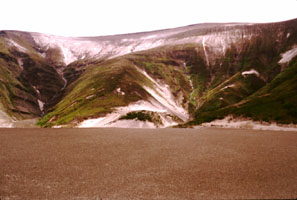
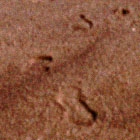 Three miles from the last "camp", the trail disappears into a trackless waste. Here the river is now at least a half mile on my left and the hillside is a quarter mile on my right. I think this is six-mile camp, but have no way of really knowing. It has taken me about 3.5 hours to reach this point. The Buttress Range has a crease within it, from which issue two gleaming streams of fresh glacial melt-water. These cascade down the hillside, and remain on the surface long enough that I must step over them. Between the two streams is a sandy track. The sand here is exceptionally fine, and one can sink many inches into it. My feet leave prints that one feels should only appear in lunar regolith.
Three miles from the last "camp", the trail disappears into a trackless waste. Here the river is now at least a half mile on my left and the hillside is a quarter mile on my right. I think this is six-mile camp, but have no way of really knowing. It has taken me about 3.5 hours to reach this point. The Buttress Range has a crease within it, from which issue two gleaming streams of fresh glacial melt-water. These cascade down the hillside, and remain on the surface long enough that I must step over them. Between the two streams is a sandy track. The sand here is exceptionally fine, and one can sink many inches into it. My feet leave prints that one feels should only appear in lunar regolith.
I decide to push on, still feeling reasonably good under my forty-eight pound pack. I stay high on the ash slopes, close to the vegetation. This turns out to be harder than it would have been to remain midway between the river and the hills, but here I can check each drainage and decide to camp or not. The next few miles are though thickening dust and increasing wind. They say that the winds can hit 150 knots on the valley floor. I doubt I've seen more than 20 knots, but it's plenty.
After another hour of hiking, I have passed two more drainages and arrived at a third. This one has two small streams coming down the hillside, only to form a small pool which disappears beneath the porous rock. Filthy snow peeks from behind the dusty coating. Beyond the pool is a deep drainage, with sides 20 feet high or more. The bed of the drainage is fairly level, is 10 yards across, and is made of fine white pumice. It looks like this might be a good camping spot. Not wanting to miss out on a better spot, I press on for another fifteen minutes, but the next two drainages have no surface water. This plus growing fatigue and dust clouds convince me to return to my previous spot.
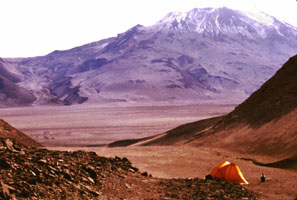 Here I erect my tent, which the wind tries to prevent. Almost as soon as I have fixed my small camp, I lay down for a needed nap. A few hours later sees me up and about to make a delectable pasta meal with scenery which would make most gravel pits look verdant. After cleaning up, I place my BRFC (Bear Resistant Food Container) a few hundred feet from my tent, then retire for the evening.
Here I erect my tent, which the wind tries to prevent. Almost as soon as I have fixed my small camp, I lay down for a needed nap. A few hours later sees me up and about to make a delectable pasta meal with scenery which would make most gravel pits look verdant. After cleaning up, I place my BRFC (Bear Resistant Food Container) a few hundred feet from my tent, then retire for the evening.
Thursday, the Fourth of July. I awake, stagger from the tent, and answer nature's call. The land is plenty light, though the temperature has dropped to the upper thirties. I leisurely prep breakfast (cream-of-wheat and tea), and contemplate today's activities. One of the rangers said that the head of the valley contains some neat lakes, and to here I will bend my will. My map shows them to be another five or six miles down the valley, at the base of Mount Mageik (pronounced Mah-Geek'). Although I could return to camp here, I decide I do not want to trust to the wind and the bears to leave my tent standing in my absence (I have seen bear tracks in the valley, possibly to stalk the animals leaving what I first took to be moose tracks, but later turned out to be caribou). I pack up everything in a lazy manner and begin hiking shortly after 9:00 am. Time means so little here with near perpetual light.
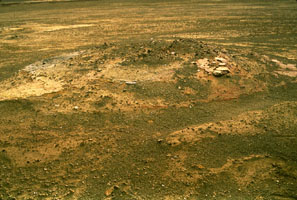 Today I hike down from the hill sides toward the river. The going seems easiest about 1/2 mile from the vegetation (what little there remains of it). Any lower, and I must hike over large mogul-like sand hills. Any higher, and I must climb in and out of drainages. For the last few miles yesterday and for all of today, I keep passing circular patches of harder mineral deposits. Each of these is where one of the 10,000 smokes issued from the ground 80 years ago. Some of them look like they may have interesting colors, but I can not tell. The soil ranges from soft with difficult traction, to harder than is pleasant to walk upon. It is comparatively level, with a gradual grade up toward where I am heading.
Today I hike down from the hill sides toward the river. The going seems easiest about 1/2 mile from the vegetation (what little there remains of it). Any lower, and I must hike over large mogul-like sand hills. Any higher, and I must climb in and out of drainages. For the last few miles yesterday and for all of today, I keep passing circular patches of harder mineral deposits. Each of these is where one of the 10,000 smokes issued from the ground 80 years ago. Some of them look like they may have interesting colors, but I can not tell. The soil ranges from soft with difficult traction, to harder than is pleasant to walk upon. It is comparatively level, with a gradual grade up toward where I am heading.
A strong (20-30 knot) headwind makes travel more difficult. Every now and again the wind smells sharply of sulfur. As I hike, the vegetation recedes further and further up the hillside until it vanishes entirely. As mentioned before, distances are impossible to judge without a scale reference, and I am consistently underestimating them.
At some point I think I am a mile from the base of the hills and a mile from the river. I see an odd moving speck halfway between me and the hills. This speck moves, and I can distinguish it as a large bull caribou, at full attention, looking at me. I unsling my camera, which I have kept strapped to my chest, despite the dust hazard, and take a picture. My photo will probably be no more than a stark wasteland with a small black dot, but I hope my film has the resolution to convey scale.
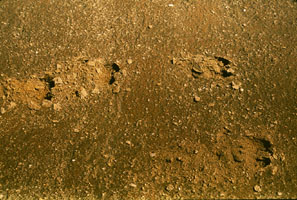 The caribou bolts toward the south (toward the head of the valley where I am heading), racing through the ash. He kicks up a plume of dust as he goes. He circles around me, leaving a good 1/2 mile berth. He briefly drops down beneath a distant hillock, then emerges to splash through the upper reaches of the Lethe (by now something I might be able to cross and no longer in a steep chasm). He recedes to the east until my eyes can no longer distinguish him in the landscape.
The caribou bolts toward the south (toward the head of the valley where I am heading), racing through the ash. He kicks up a plume of dust as he goes. He circles around me, leaving a good 1/2 mile berth. He briefly drops down beneath a distant hillock, then emerges to splash through the upper reaches of the Lethe (by now something I might be able to cross and no longer in a steep chasm). He recedes to the east until my eyes can no longer distinguish him in the landscape.
A distant dark patch makes me wonder if it is one of the lakes I am headed for. A wind kicks up a swirling dust cloud above it, blowing it toward me. I turn my back to it, leaving the sand particles to sting the backs of the my legs. The stench of sulfur is thick in the air. The dark patch is a more recent lava flow, probably from the late 1960s, come down
from Trident.
Again, my distance perception is playing tricks. What I now have assumed to be hours away is quickly growing in size. The Lethe cuts through a high embankment (60 feet or more) in a sharp V. Before long I can hear its rushing murmur. I slog through ankle deep sands, then walk across a hard plain of shattered black rock. In fifteen minutes I have climbed up the embankment and stand surveying Mageik Lakes.
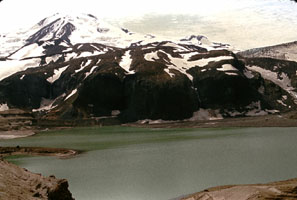 The Lakes are either three lakes or one lake, depending on interpretation. The three are connected by reasonably broad channels with obvious flow. They lie below me 40 feet or more, the lowest of the three feeding the torrential Lethe. The lakes are fed from glaciers on the sides of Mount Mageik, which I have watched approach throughout the day. It does not seem as if its 6600 foot bulk (I'm at 2000 feet) has changed much in appearance in the last five miles. There are three gorgeous waterfalls coming down from glaciers on the flanks of Mageik. The leftmost falls a dozen feet, only to hit something below and turn into a moving white fan of water. The central waterfall is the tallest, being possible 80 feet or more (again, I lack scale references), and falling as a thin trickle the entire way. The rightmost fall is the most plentiful, and runs down a filthy pile of ice. To the right of the glacier is a sharp sloped hill. Down this come tumulus rills of water, chattering as they merge and spray. These form a thick stream prior to carving their own micro-chasm in the ash and joining Mageik Lake.
The Lakes are either three lakes or one lake, depending on interpretation. The three are connected by reasonably broad channels with obvious flow. They lie below me 40 feet or more, the lowest of the three feeding the torrential Lethe. The lakes are fed from glaciers on the sides of Mount Mageik, which I have watched approach throughout the day. It does not seem as if its 6600 foot bulk (I'm at 2000 feet) has changed much in appearance in the last five miles. There are three gorgeous waterfalls coming down from glaciers on the flanks of Mageik. The leftmost falls a dozen feet, only to hit something below and turn into a moving white fan of water. The central waterfall is the tallest, being possible 80 feet or more (again, I lack scale references), and falling as a thin trickle the entire way. The rightmost fall is the most plentiful, and runs down a filthy pile of ice. To the right of the glacier is a sharp sloped hill. Down this come tumulus rills of water, chattering as they merge and spray. These form a thick stream prior to carving their own micro-chasm in the ash and joining Mageik Lake.
I climb to the highest point on my embankment, then sit to eat lunch. Here I see a beautiful white songbird. It is flashed in black, with two triangular swipes on its wings and on its tail, sort of aerobatic-competition colored, if you will. After eating lunch and resting a while, I decide it is time to head back. I stand and stretch, and, looking back the way I came, see two tiny moving specks in the distance. Using my camera with the 420mm lens, I can just make them out to be hikers. One of the rangers said she and a friend would be heading out here. This must be them.
I set out again, hoisting on my pack. I am able to choose an easier path now that I know where I am heading. It is a twenty-five minute walk before I encounter the incoming hikers. They have been walking all this while. It is likely that they were close to two miles away when I spotted them. It is indeed a ranger I had spoken with (Jenn) and a friend (an older woman who remains nameless to me). We converse briefly, complain about the sulfur smells, and continue on our ways.
The hike back is much the same as the hike in. I now have a better idea of scale, so it is not as disturbing that a feature I can see clearly takes two plus hours to reach. The sulfur smells increase, and I can see a dust storm developing on the other side of the river, the dust rising into the air several hundred feet. At times I follow the same path I hiked in on. My footprints range from lunar-perfect to completely obscured by the blowing wind. In places the ground was too hard to leave prints, but in others they have simply been erased. To avoid an incoming dust storm and to refill my water canisters, I hike up into the same drainage in which I camped last night.
The day has worked some interesting changes. The pool formed by the two streams is missing. In its place, a small channel has been cut in the sand, and the water has pushing a dozen feet downhill before being swallowed by the thirsty ash. It is disturbing to watch rocks float. I have a snack of fig newtons, stow my camera to avoid the dust, then push on.
I reach six-mile campsite in an hour. A small blue tent (clearly belonging to the other hikers) is pitched in the middle of a sand gully. The wind has knocked down one of the tent's two hoop-poles, and, if not for its bright blue color, the entire thing would look like some abandoned ghost site, not one that had been left but nine hours ago.
Still good to go, I continue to hike. I again pick up a trail, which in some ways is a great relief from the (nearly) trackless waste, and in other ways is a disappointment as it signals that I am nearing civilization. The River Lethe continues to amaze me with its sharp cut channel, and the green bedecked side streams delight as before. I reach three-mile camp, but decide that it is too rocky to make a nice campsite. Last night the fine pumice was wonderfully comfortable, if a bit dusty.
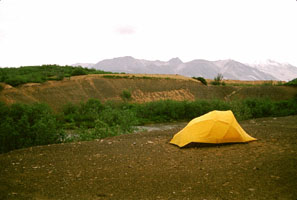 I proceed back to Windy Creek, where I cross roughly in the same spot as before. The river has become deeper since yesterday, and this time my left gaiter lets water in while my right works beautifully. I am tired, and, although it is probably only an hour and a half back to the trail head, there is no value to going to its waterless site and camping. Instead, I hike along the banks of Windy Creek for fifteen minutes, then select a high gravely bluff on which to pitch my tent.
I proceed back to Windy Creek, where I cross roughly in the same spot as before. The river has become deeper since yesterday, and this time my left gaiter lets water in while my right works beautifully. I am tired, and, although it is probably only an hour and a half back to the trail head, there is no value to going to its waterless site and camping. Instead, I hike along the banks of Windy Creek for fifteen minutes, then select a high gravely bluff on which to pitch my tent.
I use the silty creek to roughly clean the dust from my face and arms, then fetch water and make dinner. Dinner is a can of chili, which I know to be fairly poor, but tastes delicious after almost 10 full hours of hiking (probably 17.5 miles or so). I deposit my BRFC at a safe distance and retire for the evening. It is close to 11:00 pm, but there is still plenty of light.
Friday morning I awake to the sounds of rain. My tent performs perfectly, as always, and I am snug and dry (if in need of answering nature). By 7:30 am the rain has tapered off, and I emerge. Breakfast is another bowl of cream-of-wheat, followed by a slow take-down of the camp. My tent is not packed nearly so well as I would like, but, then, everything is wet. Again, I am on the trail shortly after 9 am.
I hike up Windy Creek a short distance, but here the ash has enough vegetation to make going very difficult. Every few hundred yards there is a line of chest-high willows which I must force my way through. Today I have worn long pants, as I knew I would have to go through brush (plus I have sunburned my knees). After a half hour of little progress, I decide that I have hiked enough, and turn to head out of the Valley.
 Rejoining the trail does not obviously make the going easier. To the contrary, the willow is joined by cottonwood, both of which seem expressly planted to impede progress. I fight my way through it, getting covering in moisture by the bushes. The sky is tenuous, but holding. I do encounter one plant which holds a jewel of water at the base of each fan of leaves. Flowers also begin to appear, lupens and species I am not familiar with.
Rejoining the trail does not obviously make the going easier. To the contrary, the willow is joined by cottonwood, both of which seem expressly planted to impede progress. I fight my way through it, getting covering in moisture by the bushes. The sky is tenuous, but holding. I do encounter one plant which holds a jewel of water at the base of each fan of leaves. Flowers also begin to appear, lupens and species I am not familiar with.
It is a slow push up to the trailhead. Once there, I am to hike the 2/3 mile to the Windy Creek Lookout cabin, where the bus will pick me up. The going is quick, and before long I arrive. At the cabin are three guys about my age who were out since Sunday. They have done some glacier climbing and looked upon both Novarupta, which I saw from a distance, and into Crater Lake, situated in the remains of Mount Katmai. We exchange stories to pass the time waiting for the bus.
Return to Manthey Outdoors or the Site Map.
 The bus then forded three shallow streams (one fairly wide). Sometime after this the German couple pointed out a wolf. Eventually we alarmed the bus driver enough to stop. I managed to get the correct lens on my camera and the window open in time to actually get a couple of photographs, which I hope came out well. After this we drove by a beaver pond with a huge lodge, then into an area with the first glimpse of the Valley. Here the guide said we could begin to see a brown area (I wasn't sure what area he was talking about).
The bus then forded three shallow streams (one fairly wide). Sometime after this the German couple pointed out a wolf. Eventually we alarmed the bus driver enough to stop. I managed to get the correct lens on my camera and the window open in time to actually get a couple of photographs, which I hope came out well. After this we drove by a beaver pond with a huge lodge, then into an area with the first glimpse of the Valley. Here the guide said we could begin to see a brown area (I wasn't sure what area he was talking about).
 From my dropoff point you can look down on the Valley of 10,000 Smokes, which isn't all that impressive from there. The Valley is fifteen plus miles long and four miles wide. It looks to be a desert-like ash field with occasional blowing sand (ash, really). This is framed on one side by the Buttress Range, a series of low mountains as high as 3500 feet. The Valley floor is at 1100 feet at the base and 2000 feet at the top. On the other side of the Valley is Mount Griggs (7600+ feet), what is left of Mount Katmai (at one time a rival of Mount Griggs in height, now only 5000 feet at its highest), Baked and Broken Mountains (two scorched-earth hills of 3700 feet or so), and a few other mountains. At the far end of the Valley lie Mount Mageik (on the Buttress Range side) and Mount Trident, both active volcanoes which release steam at times. Novarupta, the source of the desolation, lies between Baked Mountain, Mount Katmai, and Trident Mountain.
From my dropoff point you can look down on the Valley of 10,000 Smokes, which isn't all that impressive from there. The Valley is fifteen plus miles long and four miles wide. It looks to be a desert-like ash field with occasional blowing sand (ash, really). This is framed on one side by the Buttress Range, a series of low mountains as high as 3500 feet. The Valley floor is at 1100 feet at the base and 2000 feet at the top. On the other side of the Valley is Mount Griggs (7600+ feet), what is left of Mount Katmai (at one time a rival of Mount Griggs in height, now only 5000 feet at its highest), Baked and Broken Mountains (two scorched-earth hills of 3700 feet or so), and a few other mountains. At the far end of the Valley lie Mount Mageik (on the Buttress Range side) and Mount Trident, both active volcanoes which release steam at times. Novarupta, the source of the desolation, lies between Baked Mountain, Mount Katmai, and Trident Mountain. Shortly after passing this point, the trail is squeezed in between the sharp sides of the Buttress Range and the chasm which holds the River Lethe. The River Lethe is an awesome spectacle. Although no gullies channel water to it, it still receives a significant quantity of ash-silt laden water. These pour from the cliffsides into its 200-foot deep chasm, where the river runs in sharp torrents. I am pleased I have chosen not to cross it.
Shortly after passing this point, the trail is squeezed in between the sharp sides of the Buttress Range and the chasm which holds the River Lethe. The River Lethe is an awesome spectacle. Although no gullies channel water to it, it still receives a significant quantity of ash-silt laden water. These pour from the cliffsides into its 200-foot deep chasm, where the river runs in sharp torrents. I am pleased I have chosen not to cross it.
 Three miles from the last "camp", the trail disappears into a trackless waste. Here the river is now at least a half mile on my left and the hillside is a quarter mile on my right. I think this is six-mile camp, but have no way of really knowing. It has taken me about 3.5 hours to reach this point. The Buttress Range has a crease within it, from which issue two gleaming streams of fresh glacial melt-water. These cascade down the hillside, and remain on the surface long enough that I must step over them. Between the two streams is a sandy track. The sand here is exceptionally fine, and one can sink many inches into it. My feet leave prints that one feels should only appear in lunar regolith.
Three miles from the last "camp", the trail disappears into a trackless waste. Here the river is now at least a half mile on my left and the hillside is a quarter mile on my right. I think this is six-mile camp, but have no way of really knowing. It has taken me about 3.5 hours to reach this point. The Buttress Range has a crease within it, from which issue two gleaming streams of fresh glacial melt-water. These cascade down the hillside, and remain on the surface long enough that I must step over them. Between the two streams is a sandy track. The sand here is exceptionally fine, and one can sink many inches into it. My feet leave prints that one feels should only appear in lunar regolith. Here I erect my tent, which the wind tries to prevent. Almost as soon as I have fixed my small camp, I lay down for a needed nap. A few hours later sees me up and about to make a delectable pasta meal with scenery which would make most gravel pits look verdant. After cleaning up, I place my BRFC (Bear Resistant Food Container) a few hundred feet from my tent, then retire for the evening.
Here I erect my tent, which the wind tries to prevent. Almost as soon as I have fixed my small camp, I lay down for a needed nap. A few hours later sees me up and about to make a delectable pasta meal with scenery which would make most gravel pits look verdant. After cleaning up, I place my BRFC (Bear Resistant Food Container) a few hundred feet from my tent, then retire for the evening. Today I hike down from the hill sides toward the river. The going seems easiest about 1/2 mile from the vegetation (what little there remains of it). Any lower, and I must hike over large mogul-like sand hills. Any higher, and I must climb in and out of drainages. For the last few miles yesterday and for all of today, I keep passing circular patches of harder mineral deposits. Each of these is where one of the 10,000 smokes issued from the ground 80 years ago. Some of them look like they may have interesting colors, but I can not tell. The soil ranges from soft with difficult traction, to harder than is pleasant to walk upon. It is comparatively level, with a gradual grade up toward where I am heading.
Today I hike down from the hill sides toward the river. The going seems easiest about 1/2 mile from the vegetation (what little there remains of it). Any lower, and I must hike over large mogul-like sand hills. Any higher, and I must climb in and out of drainages. For the last few miles yesterday and for all of today, I keep passing circular patches of harder mineral deposits. Each of these is where one of the 10,000 smokes issued from the ground 80 years ago. Some of them look like they may have interesting colors, but I can not tell. The soil ranges from soft with difficult traction, to harder than is pleasant to walk upon. It is comparatively level, with a gradual grade up toward where I am heading. The caribou bolts toward the south (toward the head of the valley where I am heading), racing through the ash. He kicks up a plume of dust as he goes. He circles around me, leaving a good 1/2 mile berth. He briefly drops down beneath a distant hillock, then emerges to splash through the upper reaches of the Lethe (by now something I might be able to cross and no longer in a steep chasm). He recedes to the east until my eyes can no longer distinguish him in the landscape.
The caribou bolts toward the south (toward the head of the valley where I am heading), racing through the ash. He kicks up a plume of dust as he goes. He circles around me, leaving a good 1/2 mile berth. He briefly drops down beneath a distant hillock, then emerges to splash through the upper reaches of the Lethe (by now something I might be able to cross and no longer in a steep chasm). He recedes to the east until my eyes can no longer distinguish him in the landscape. The Lakes are either three lakes or one lake, depending on interpretation. The three are connected by reasonably broad channels with obvious flow. They lie below me 40 feet or more, the lowest of the three feeding the torrential Lethe. The lakes are fed from glaciers on the sides of Mount Mageik, which I have watched approach throughout the day. It does not seem as if its 6600 foot bulk (I'm at 2000 feet) has changed much in appearance in the last five miles. There are three gorgeous waterfalls coming down from glaciers on the flanks of Mageik. The leftmost falls a dozen feet, only to hit something below and turn into a moving white fan of water. The central waterfall is the tallest, being possible 80 feet or more (again, I lack scale references), and falling as a thin trickle the entire way. The rightmost fall is the most plentiful, and runs down a filthy pile of ice. To the right of the glacier is a sharp sloped hill. Down this come tumulus rills of water, chattering as they merge and spray. These form a thick stream prior to carving their own micro-chasm in the ash and joining Mageik Lake.
The Lakes are either three lakes or one lake, depending on interpretation. The three are connected by reasonably broad channels with obvious flow. They lie below me 40 feet or more, the lowest of the three feeding the torrential Lethe. The lakes are fed from glaciers on the sides of Mount Mageik, which I have watched approach throughout the day. It does not seem as if its 6600 foot bulk (I'm at 2000 feet) has changed much in appearance in the last five miles. There are three gorgeous waterfalls coming down from glaciers on the flanks of Mageik. The leftmost falls a dozen feet, only to hit something below and turn into a moving white fan of water. The central waterfall is the tallest, being possible 80 feet or more (again, I lack scale references), and falling as a thin trickle the entire way. The rightmost fall is the most plentiful, and runs down a filthy pile of ice. To the right of the glacier is a sharp sloped hill. Down this come tumulus rills of water, chattering as they merge and spray. These form a thick stream prior to carving their own micro-chasm in the ash and joining Mageik Lake. I proceed back to Windy Creek, where I cross roughly in the same spot as before. The river has become deeper since yesterday, and this time my left gaiter lets water in while my right works beautifully. I am tired, and, although it is probably only an hour and a half back to the trail head, there is no value to going to its waterless site and camping. Instead, I hike along the banks of Windy Creek for fifteen minutes, then select a high gravely bluff on which to pitch my tent.
I proceed back to Windy Creek, where I cross roughly in the same spot as before. The river has become deeper since yesterday, and this time my left gaiter lets water in while my right works beautifully. I am tired, and, although it is probably only an hour and a half back to the trail head, there is no value to going to its waterless site and camping. Instead, I hike along the banks of Windy Creek for fifteen minutes, then select a high gravely bluff on which to pitch my tent. Rejoining the trail does not obviously make the going easier. To the contrary, the willow is joined by cottonwood, both of which seem expressly planted to impede progress. I fight my way through it, getting covering in moisture by the bushes. The sky is tenuous, but holding. I do encounter one plant which holds a jewel of water at the base of each fan of leaves. Flowers also begin to appear, lupens and species I am not familiar with.
Rejoining the trail does not obviously make the going easier. To the contrary, the willow is joined by cottonwood, both of which seem expressly planted to impede progress. I fight my way through it, getting covering in moisture by the bushes. The sky is tenuous, but holding. I do encounter one plant which holds a jewel of water at the base of each fan of leaves. Flowers also begin to appear, lupens and species I am not familiar with.